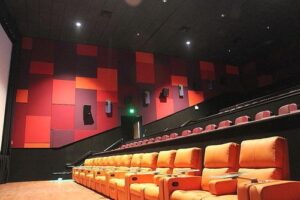Auditorium Acoustics in Dubai
Home -> Auditorium Acoustics in Dubai

Auditoriums require excellent sound quality for voice and music, delivering crisp and clear sound to the Audience. An auditorium must provide a place where speech can be clearly understood. This means a good auditorium will have a good intelligibility rating.
The set of minimum acoustic requirements that are met by a working auditorium starts with the direct sound from the speaker being loud enough, which means it replicates conversational sound levels. The background noise in the hall must be quiet. The auditorium acoustics should be free from echoes and other types of late reflections. And finally, the auditorium acoustic is not very reverberant at all.
- Auditorium Sound Proofing
The primary aim of auditorium acoustics is to improve the sound quality inside the Auditorium and to provide equal quality of premium sound to everybody regardless of their seating position. Auditoriums can be different by design. But if that sound is distorted because of the echoes in the room, the audience will have a difficult time interpreting what’s happening on stage. Blurred sound signals will destroy the user friendliness of the room. By placing auditorium acoustic materials such as Sound Absorption panels, wooden panels, on the perimeter wall or ceiling surfaces in the Auditorium, the background noise can be cleaned. Acoustic Foam and Sound Proofing with Mass loaded Vinyl Barrier can also be considered. Acoustic Ceiling Clouds with different sizes and shapes will be used in Auditorium designs.
Design Requirements in Auditorium Acoustics in Dubai
Auditorium acoustic treatment is a complex subject with many variables and options to treat those issues. While designing the auditorium, we have to take care of all these things in our minds and design the auditorium in such a way that the distribution of sound will be equal to the participant sitting in the front row and as well as the audience sitting in the last row.
Perfect acoustician means, perfection in understanding scientific principles and mathematical calculations. INVIOT is capable enough to deliver the best Auditorium Acoustics in Dubai considering all the design aspects in the most effective way. Acoustic consultant INVIOT and professionals work closely with architects, engineers, and performers to design and optimize auditorium spaces, ensuring an immersive and enjoyable listening experience for both performers and audiences.
- There should be adequate loudness in every part of the Auditorium to reduce the Sound Energy Loss
- The parallelism between opposite Sound reflective boundary surfaces should be avoided to eliminate undesirable back reflections
- The Floor area and the volume of the Auditorium should be kept at a reasonable minimum shortening the distance that the direct and reflected sound must travel.
- The Sound source must be raised as much as feasible in order to secure a free flow of direct sound sources to every listener.
- The Floor where the Audience is seated should be properly ramped or raked because the sound is more readily absorbed when it travels over the audience at grazing incidence
- The Sound source should be closely and abundantly surrounded with large sound reflective surfaces in order to supply additional reflected sound energy to every portion of the Audience
Frequently Asked Questions
Auditorium acoustics are crucial to ensure optimal sound quality and clarity for both performers and audience members. Proper acoustics enhance the listening experience, allow clear communication during presentations, and create a more immersive environment for performances
Several factors influence auditorium acoustics, including the size and shape of the room, the materials used in construction, the placement of sound-absorbing and sound-reflecting surfaces, the design of the stage and seating area, and the presence of any acoustic treatments or panels
Sound absorption refers to the process of reducing sound reflections by absorbing sound energy. It involves using materials that convert sound waves into heat. Sound diffusion, on the other hand, scatters sound waves in multiple directions, helping to reduce sound concentration in specific areas and create a more balanced acoustic environment
To control echoes and reverberations in an auditorium, sound-absorbing materials are strategically placed on walls, ceilings, and other surfaces. This helps reduce the reflection of sound waves and minimizes the buildup of excessive reverberations, leading to improved speech intelligibility and sound clarity
Yes, auditorium acoustics can be adjustable to some extent. Some modern auditoriums use motorized or retractable acoustic panels that can be deployed or adjusted based on the specific needs of different events. These panels can control the room’s acoustic characteristics, making it suitable for concerts, lectures, theatrical performances, and other activities
The “RT60” measurement refers to the time it takes for sound reflections in a room to decrease by 60 decibels after the sound source has stopped. It is an essential parameter in auditorium acoustics and helps determine the room’s reverberation time. The appropriate RT60 value varies depending on the type of auditorium and the intended use
Various organizations and acoustic experts have established guidelines for auditorium acoustics. For example, the American National Standards Institute (ANSI) and the International Electrotechnical Commission (IEC) have published standards related to room acoustics and sound system performance.
Yes, existing auditoriums can be retrofitted with acoustic treatments to improve their sound quality. This may involve adding sound-absorbing panels, diffusers, or other acoustic elements to enhance the room’s acoustics
The shape of an auditorium can significantly impact its acoustics. Certain shapes, such as shoebox or fan-shaped configurations, tend to offer better sound distribution and reduced sound reflections compared to irregularly shaped rooms
The positioning of speakers in an auditorium’s sound system is crucial for achieving balanced sound coverage and accurate localization of audio sources. Proper speaker placement ensures that sound reaches all audience members evenly and complements the room’s acoustics
